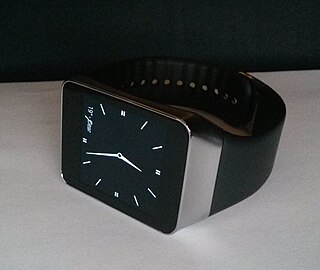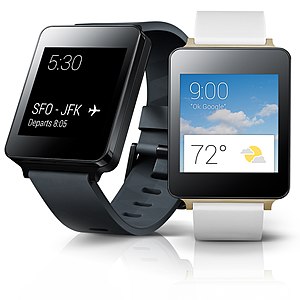
LG Electronics Inc. is a South Korean multinational major appliance and consumer electronics corporation headquartered in Yeouido-dong, Seoul, South Korea. LG Electronics is a part of LG Corporation, the fourth largest chaebol in South Korea, and often considered as the pinnacle of LG Corp with the group's chemical and battery division LG Chem. It comprises four business units: home entertainment, mobile communications, home appliances & air solutions, and vehicle components. LG Electronics acquired Zenith in 1995 and is the largest shareholder of LG Display, the world's largest display company by revenue in 2020. LG Electronics is also the world's second largest television manufacturer behind Samsung Electronics. The company has 128 operations worldwide, employing 83,000 people.
A mobile operating system is an operating system used for smartphones, tablets, smartwatches, smartglasses, or other non-laptop personal mobile computing devices. While computers such as typical/mobile laptops are "mobile", the operating systems used on them are generally not considered mobile, as they were originally designed for desktop computers that historically did not have or need specific mobile features. This line distinguishing mobile and other forms has become blurred in recent years, due to the fact that newer devices have become smaller and more mobile unlike hardware of the past. Key notabilities blurring this line are the introduction of tablet computers, light-weight laptops, and the hybridization of the two in 2-in-1 PCs.

A smartwatch is a portable and wearable computer device in a form of a watch; modern smartwatches provide a local touchscreen interface for daily use, while an associated smartphone app provides management and telemetry, such as long-term biomonitoring. While early models could perform basic tasks such as calculations, digital time telling, translations, and game-playing, smartwatches released since 2015 have more general functionality closer to smartphones, including mobile apps, a mobile operating system, and WiFi/Bluetooth connectivity. Some smartwatches function as portable media players, with FM radio and playback of digital audio and video files via a Bluetooth headset. Some models, called watch phones, have mobile cellular functionality such as making telephone calls.
Universal Display Corporation is a developer and manufacturer of organic light emitting diodes (OLED) technologies and materials as well as provider of services to the display and lighting industries. It is also an OLED research company. Founded in 1994, the company currently owns or has exclusive, co-exclusive or sole license rights with respect to more than 3,000 issued and pending patents worldwide for the commercialization of phosphorescent based OLEDs and also flexible, transparent and stacked OLEDs - for both display and lighting applications. Its phosphorescent OLED technologies and materials are licensed and supplied to companies such as Samsung, LG, AU Optronics CMEL, Pioneer, Panasonic Idemitsu OLED lighting and Konica Minolta.

The Samsung Galaxy Gear is a smartwatch produced by Samsung Electronics in the Samsung Gear family of devices. Unveiled during a Samsung Unpacked event in Berlin, Germany on September 4, 2013, the device serves as a companion for all Samsung Galaxy smartphones and tablets which runs on Android 4.3 "Jelly Bean" or newer. It was released on September 25, 2013. Originally released as an Android-based device, Samsung replaced the operating system with Tizen through the May 2014 software update.

The Omate TrueSmart is a smartwatch designed by Omate, a Chinese company based in Hong Kong and Shenzhen. It has been funded by crowd funding via Kickstarter. The funding period was from August 21, 2013 until September 20, 2013. The funding goal of $100,000 was reached within 12 hours, with more than $1,032,000 raised by the end of the campaign. In contrast to other smartwatches, the Omate is a complete standalone telecom mobile device that can be used to make calls, navigate and use Android apps independent of the user's smartphone.

Wear OS is a version of Google's Android operating system designed for smartwatches and other wearables. By pairing with mobile phones running Android version 6.0 "Marshmallow" or newer, or iOS version 10.0 or newer with limited support from Google's pairing application, Wear OS integrates Google Assistant technology and mobile notifications into a smartwatch form factor. Wear OS is closed-source, in contrast to the free and open-source Android.

The Moto 360 is an Android Wear-based smartwatch announced by Motorola Mobility in 2014. It was announced on March 18, 2014 and was released on September 5, 2014 in the US along with new models of the Moto X and the Moto G.

The Samsung Gear Live is an Android Wear-based smartwatch announced and released by Samsung and Google on June 25, 2014. It was released along with the LG G Watch as launch devices for Android Wear, a modified version of Android designed specifically for smartwatches and other wearables. Gear Live is the 5th device launched in the Samsung Gear family of wearables. It is compatible with all smartphones running Android 4.3 or higher that support Bluetooth Smart.

Samsung Gear S is a smartwatch designed and marketed by Samsung Electronics. It was announced on August 28, 2014, as the successor to the Samsung Gear 2 and was released on November 7, 2014. The smartwatch can be modified to run Android 5.1.1 or Wear OS 6.0.1.

The LG G Watch R is an Android Wear-based smartwatch announced and released by LG and Google on October 25, 2014. It is the second round-faced smartwatch after the Motorola Moto 360 but, unlike the 360, it is the first to feature a full circular display. It is the successor to LG's original LG G Watch, which features a rectangular display.

Here WeGo is a web mapping and satellite navigation software, operated by HERE Technologies and available on the Web and mobile platforms. It is based on HERE's location data platform, providing its in-house data, which includes satellite views, traffic data, and other location services. Maps are updated every two or three months.
The Moto 360 , also known as the Moto 360 (2015), is an Android Wear-based smartwatch. It was announced on September 14, 2015 at the IFA.

myTuner Radio, or simply myTuner, is an Internet radio app directory/platform owned by AppGeneration – Software Technologies, Lda, a development company based in Porto, Portugal founded by Eduardo Carqueja in October 2010. myTuner Radio has over 50,000 radio stations and one million podcasts from all around the world. On June 7, 2017, AppGeneration announced that its service had over 30 million users and a database with radio stations of 200 countries. my Turner Radio platform is available for the web at mytuner-radio.com, for a suite of mobile apps: iOS, Google Play, Samsung, Huawei, Amazon, Windows Phone; for desktop devices: Web, Windows, and Mac, wearables: Apple Watch and Android Wearables, for connected devices like Apple TV, Samsung TVs, LG TVs, TV sets and set-top boxes with Android TV, Amazon Fire TV, Roku TV and Chromecast, connected cars: Apple Carplay, Android Auto, Bosch mySPIN, Jaguar & Land Rover InControl Apps, and also on home appliances and smart speakers like Alexa and Sonos.
Mobvoi Information Technology Company Limited is a technological company headquartered in Beijing, China that sells and develops consumer electronics and Chinese voice recognition, natural language processing, and vertical search technology in-house.

postmarketOS is an operating system primarily for smartphones, based on the Alpine Linux distribution.

Google Pay is a mobile payment service developed by Google to power in-app, online, and in-person contactless purchases on mobile devices, enabling users to make payments with Android phones, tablets, or watches. Users can authenticate via a PIN, passcode, or biometrics such as 3D face scanning or fingerprint recognition.

The Samsung Galaxy Watch 4 is a smartwatch developed by Samsung Electronics. It is the first Samsung watch to run Google's Wear OS since the Samsung Gear Live, and the first watch to run Wear OS 3, co-developed by Samsung and Google. The device largely followed the design language of the preceding Samsung Galaxy Watch Active and Galaxy Watch 3, but including all new software. The watch also included EKG, body compositional analysis, and blood pressure monitoring via the new Samsung BioActive sensor. It was announced on August 11, 2021, at Samsung's Unpacked Event alongside the Samsung Galaxy Z Flip 3, Samsung Galaxy Z Fold 3 and Galaxy Buds 2. The watch was released worldwide on August 27, 2021.

The Pixel Watch is a Wear OS smartwatch designed, developed, and marketed by Google as part of the Google Pixel product line. First previewed in May 2022 during the Google I/O keynote, it features a round dome-shaped display as well as deep integration with Fitbit, which Google acquired in 2021. Two Pixel-branded smartwatches had been in development at Google by July 2016, but were canceled ahead of their release due to hardware chief Rick Osterloh's concerns that they did not fit well with other Pixel devices. Development on a new Pixel-branded watch began shortly after Google's acquisition of Fitbit.














